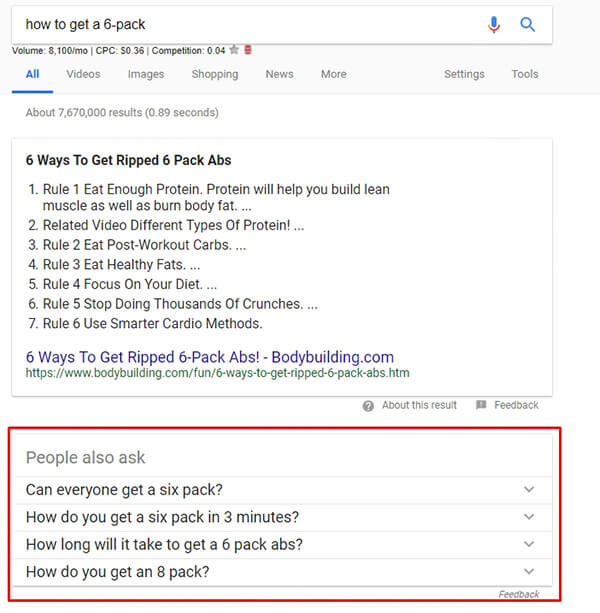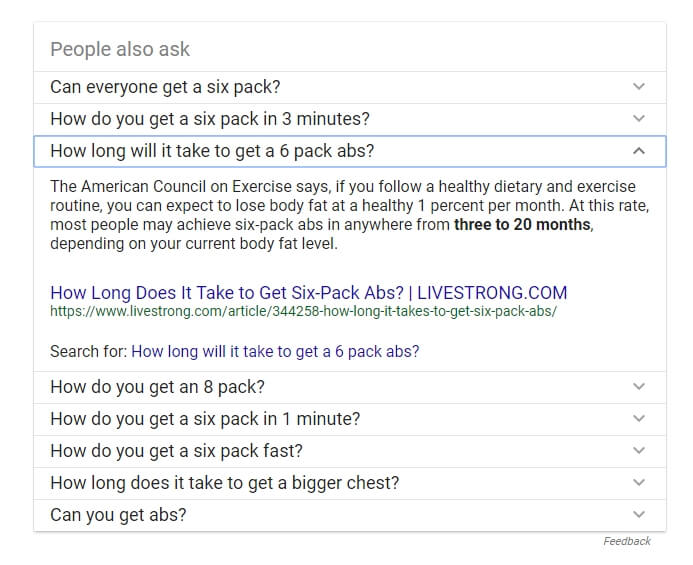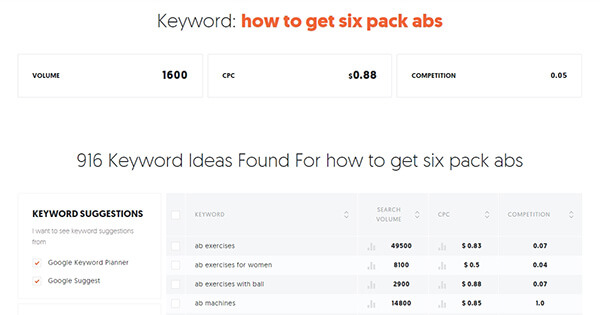When it comes to most things in SEO, it’s important to choose quality over quantity.
Instead of buying 100 lame links, earn 5 legitimate ones. Don’t build 10 boilerplate pages with duplicate copy. Instead, put some blood sweat and tears into 2 high-value and well-targeted pages.
Similarly, when you’re doing your keyword research, it’s important to be surgical. The “shotgun” strategy will only work if you’re in a really uncompetitive niche. Keyword diversity matters, but so to does how you optimize for those target keywords.
Sometimes, it’s easiest to explain these concepts with specific examples. So let’s go that route.
Say you’ve been hitting the weights and you’re feeling pretty jacked. After admiring your guns, you decide that you should write a guide to getting ripped.
Fast-forward a few days and you’ve got a 3,000 word manifesto.
It’s packed with step-by-step instructions, tips, and product recommendations.
After doing your diligence on keywords, you’re pretty sure that your target audience will use the following keywords on Google…
- How to build muscle?
- How to gain muscle mass?
- How can I make gains?
Whatever term they end up using, the searcher intent is still the same. This audience is going to be looking for guides on how to build bigger muscles.
As you can see, this is a pretty compelling reason for webmasters and SEO practitioners to optimize individual pages for a careful selection of keywords.
Another reason to do this, is that there’s often an overlap between different keywords and their intent. In the example above, another usable keyword is “whey protein powder.” This may be an affiliate product you’re trying to sell.
Makes sense, right? After all, the reader’s end goal is to gain muscles. To them, it’s going to be all about the results. That could include equipment, food, techniques, etc.
Focus on selling the solution, not the product or service. Click To TweetSo we’ve established why it makes sense to optimize pages for multiple keywords. Now let’s take a look at how to best go about this.
Do Your Keyword Research First
The first step is to find keyword variations that make sense for your topic.
There is no shortage of tools, tips or tricks when it comes to keyword research. But an easy approach is to start by performing a search on Google.
Then take a look at the “people also ask” box to get additional ideas and keyword phrases that belie a similar searcher intent.

Now, you’ve probably noticed that it’s not guaranteed that the searcher intent will always match our keyword objectives. Just focus on the ones that do align with the original search to discover more variations.
In this case, we could probably make do with any of these “people also ask” suggestions. But for the sake of brevity, let’s go with “How long will it take to get six pack abs”. As you’ll see below, this will also add new suggestions to the “People also ask” box.

Feel free to go three or even four levels deeper. Once a list of relevant search phrases is made, you can start cruncing numbers.
A keyword research tool like Ubersuggest comes in handy for this. After you enter a search phrase from your list, it gives you more keyword suggestions and their associated search volume.

Keep in mind that monthly search volume will be an estimate, regardless of what tool you’re using (this applies even to Google’s own tools as well). But this data can still help you gauge the demand for each keyword.
There are any number of tools you can use to get more keyword data and ideas. For more on this, check out our guide to keyword research.
Optimizing One Page for Multiple Keywords
You should now have enough keyword variations to effectively cover your subject matter. But the question still remains: how do you optimize a single page for all of them?
Truth be told, it all boils down to proper keyword placement. Here’s how to focus your efforts.
The H1 Tag
First and foremost, you’ll want to optimize your H1 or the header tag for your target keywords. Keep in mind that it should read naturally and make logical sense.
So, you definitely don’t want your end result to look like “How to Get Six Pack Abs, Can I Get A Six-Pack?”
- “Yes, You Can Get a Six-Pack. Here’s How!”
- “How To Get a Six Pack with 10 Minute Workouts”
There are no strict rules of course, and these are going to require some serious creativity. But have fun! Writing headlines can be entertaining and deliver big results when done correctly.
Subheadings
The advantage of subheadings is that you can use as many as you want. This means you can naturally integrate multiple keywords into separate subheadings. The best case scenario is when you’re writing a listicle. Your keywords can refer to different items on the list.
Meta Description
Optimizing meta descriptions for multiple keywords is slightly different. While they can affect click-through rates, they are a non-factor when it comes to rankings. That said, you can and should incorporate multiple keywords in a natural and contextual way.
For example, your meta description can start with:
“We carry all of the best dog accessories, toys, and pet supplies in the Greater Wisconsin area.”
Main Body
Finally, remember that keyword density isn’t as important as it once was in an SEO strategy. Instead, focus on content quality, value, and the use of natural language.
This means you don’t have to force multiple keywords into the main body. But it’s best if you insert them at least once or twice. You can also use them as anchor texts in your link-building schemes.
But whatever you do, the keywords shouldn’t hurt user experience or flow. Also, do your best to ensure that the content answers the questions asked.
Google no longer cares about keyword density. It’s all about the value of your content. Click To TweetOne final note… if optimizing your page for multiple keywords is going to negatively impact the quality or user experience of your content, don’t do it. Please, just don’t. Instead, that would be a prime opportunity to create separate landing pages or posts for the more distant variants of your original keyword focus.
Remember that SEO is a very competitive landscape. You simply can’t afford to cut corners.
Conclusion
Well-researched content is essential to earning higher ranks in Google. There’s no way around it.
Making the most of your content is a great way to get more bang for your buck. So do your keyword research diligently, and optimize your content and site pages for as many close keyword variants as you can while remaining reasonable.








